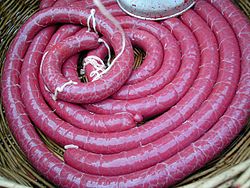
Back Blutwurst ALS Morciella AN Blōdmearh ANG سجق الدم Arabic Blunzen BAR Krovėnis BAT-SMG Крывянка BE Крывянка BE-X-OLD Кървавица Bulgarian Sosis darah BJN
This article needs additional citations for verification. (July 2014) |
 French blood sausage (boudin noir), before cooking | |
| Alternative names | Blood pudding, black pudding |
|---|---|
| Serving temperature | Hot |
| Main ingredients | Blood, grains, meat products, onions, spices |
| Nutritional value per 100 g (3.5 oz) | |
|---|---|
| Energy | 1,586 kJ (379 kcal) |
1 g | |
| Sugars | 1 g |
35 g | |
15 g | |
| Minerals | Quantity %DV† |
| Iron | 36% 6.4 mg |
| Sodium | 30% 680 mg |
This is one of many types of blood sausage, likely with a large amount of added bacon. | |
| †Percentages estimated using US recommendations for adults,[1] except for potassium, which is estimated based on expert recommendation from the National Academies.[2] | |
A blood sausage is a sausage filled with blood that is cooked or dried and mixed with a filler until it is thick enough to solidify when cooled. Most commonly, the blood of pigs, sheep, lamb, cow, chicken, or goose is used.[3]
In Europe and the Americas, typical fillers include meat, fat, suet, bread, cornmeal, onion, chestnuts, barley, oatmeal and buckwheat. On the Iberian Peninsula and in Latin America and Asia, fillers are often made with rice. Sweet variants with sugar, honey, orange peel and spices are also regional specialties.
In many languages, there is a general term such as blood sausage (American English) that is used for all sausages that are made from blood, whether or not they include non-animal material such as bread, cereal, and nuts. Sausages that include such material are often referred to with more specific terms, such as black pudding in English.[4] Other varieties of blood sausage include boudin rouge (Creole and Cajun), rellena or moronga (Mexico), and sanganel (Friuli).
- ^ United States Food and Drug Administration (2024). "Daily Value on the Nutrition and Supplement Facts Labels". Retrieved 28 March 2024.
- ^ National Academies of Sciences, Engineering, and Medicine; Health and Medicine Division; Food and Nutrition Board; Committee to Review the Dietary Reference Intakes for Sodium and Potassium (2019). Oria, Maria; Harrison, Meghan; Stallings, Virginia A. (eds.). Dietary Reference Intakes for Sodium and Potassium. The National Academies Collection: Reports funded by National Institutes of Health. Washington (DC): National Academies Press (US). ISBN 978-0-309-48834-1. PMID 30844154.
{{cite book}}: CS1 maint: multiple names: authors list (link) - ^ "Blood sausages". meatsandsausages.com. Retrieved 22 December 2020.
- ^ "A Guide To Traditional Black Pudding". English Breakfast Society. Retrieved 4 November 2019.